In case some of you long-time readers feel a sense of deja vu as you read this Post, you are to be congratulated for having a good memory. I promised to write on the Transfiguration, but this was one of the rare weeks when I just couldn’t come up with anything. So I searched back in the files, and sure enough I had written on the subject five years ago. (It was news to me!) I thought that Post was not bad, but it could use some serious revision. * And here it is:
- Oh, I’ve got tell you a story: This reminds me of the time when Dr Robert Dentan, one of the professors at the Episcopalian seminary I attended, had written an excellent book summing up the story of the Bible which he titled simply The Holy Scriptures. He decided it needed some improvement, so he wrote a revised edition. The New York Times wrote a review which they titled “The Holy Scriptures Revised by Robert Dentan”!
Now to the subject at hand:
The Transfiguration
August 6
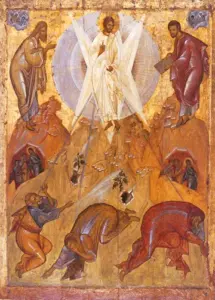
This is one of the Great Feasts of the Church – but I’ll bet if you asked Americans “What is the Transfiguration?”, ninety nine out of a hundred would say “Eh?” Or maybe some might think it was the latest super-hero movie.
Back in the “old countries” the churches will be filled for the Feast. The problem with Transfiguration here in the Western world is that other Christians don’t emphasize it – many ignore it entirely – so we rarely hear about it. Also it falls at the time of year when half everybody is out of town or at least mentally on vacation, enjoying the good weather while it lasts – which, God knows, doesn’t last that long up here in the northern climes. The result is that those who come to Transfiguration Liturgy feel very blessed but usually also pretty lonesome.
Thus we lose much, because Orthodox theologians have long said that the Transfiguration is central to our understanding of Jesus of Nazareth. Here, for the first time, He was seen in His heavenly Glory: an awe-inspiring event which showed who He truly is, and what He calls us to become – and much more.
Let’s look the story. It appears in all three of the Synoptic Gospels, among which there are only very minor differences. It’s short, so I’ll include it for you here. Let’s take the version in Matthew, chapter 17:
1 Now after six days Jesus took Peter, James, and John his brother, led them up on a high mountain by themselves; 2 and He was transfigured before them. His face shone like the sun, and His clothes became as white as the light. 3 And behold, Moses and Elijah appeared to them, talking with Him. 4 Then Peter answered and said to Jesus, “Lord, it is good for us to be here; if You wish, let us make here three tabernacles: one for You, one for Moses, and one for Elijah.”
5 While he was still speaking, behold, a bright cloud overshadowed them; and suddenly a voice came out of the cloud, saying, “This is My beloved Son, in whom I am well pleased. Hear Him!” 6 And when the disciples heard it, they fell on their faces and were greatly afraid. 7 But Jesus came and touched them and said, “Arise, and do not be afraid.” 8 When they had lifted up their eyes, they saw no one but Jesus only.
9 Now as they came down from the mountain, Jesus commanded them, saying, “Tell the vision to no one until the Son of Man is risen from the dead.”
The Background
The first verse begins “After six days…” Six days after what?
Six days before this Jesus had finally asked His Apostles the big question: “Who do you say that I am?” Simon Peter, as usual, had blurted it out: “You are the Christ, the Son of the living God”.
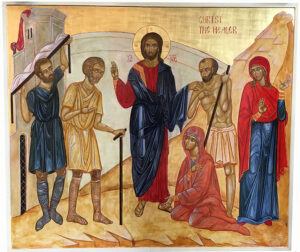
He had been leading them up to this point. At the beginning He had made a miraculous catch of fish, of all things! Then they had seen Him cast out demons, heal the sick, feed thousands (twice) with only a little bread and a few fish. He had walked on the water of the Sea. He had raised a dead girl to life.
Unlike the scribes and lawyers who only quoted the texts, Jesus spoke with authority, as if He knew the ultimate answers for Himself.
As He healed a man, He had claimed to forgive his sins, scandalizing the Pharisees who complained, accurately, that only God can forgive sins. He had claimed to be Lord of the Sabbath. He said His words superseded the Old Testament Law: “In times of old it was said to you, but I say to you…” By a word He had calmed a storm, causing His Apostles ask, “What sort of man is this, that even the wind and waves obey Him?”
What sort of Man indeed? Step by step He had led these twelve men to believe what had seemed utterly inconceivable to them, but what they were now all been wondering and talking about. Now they were ready. He asked the question: “Who do you say that I am?” Peter, as usual, blurted it out: “You are the Christ, the Son of the living God” – the long-awaited Messiah, divine as your Father is divine, just as human sons are human like their fathers. The impossible thing has happened: “God has been made flesh and has dwelt among us.”
I imagine Peter couldn’t believe he had finally said it aloud. But Jesus immediately confirmed it. “Blessed are you, Peter, son of Jonah. Flesh and blood have not revealed this to you, but my Father in Heaven.”
Then He immediately told His disciples another inconceivable thing: that He the Messiah must suffer and die and on the third day be raised.
So the Transfiguration took place in context of these two things: Jesus is Son of God. He must die. To their horror, Peter cried, “No, Lord. We will never let this happen to You.”. Jesus answered “Get behind me, Satan. You think as man thinks, not as God thinks.”
It was six days after these mind-boggling events that Jesus took with Him Peter, James and John, * to go with Him up on a high mountain. It was time to confirm in action what they had said in words. Was this experience something the other disciples couldn’t handle yet.? The Lord reveals His Glory to those who can cope with it – or almost cope with it, as we shall see.
- These three were His “inner circle” to whom He was closest. He had taken only these three to be with Him when He raised Jairus’ daughter. He would later call them to be with Him in the Garden of Gethsemane.
The Transfiguration

Which mountain was it? Ancient Tradition, which our hymns reflect, said it was Mount Tabor, six miles southeast of Nazareth, 1300 feet high. (There’s a parking lot below it today.) Some modern scholars insist it couldn’t have been Tabor. I just ignore them. I trust ancient tradition more than I trust modern educated guesses.
Luke’s account says the Apostles were heavy with sleep. Was it nighttime? or were they just weary from the climb? Or sometimes peoples’ reaction to an encounter with the Holy is sleep. When God appeared to Moses in smoke and fire he fell into a deep sleep, a kind of trance. Genesis 15
And Jesus was transfigured. The Greek word for this is “metamorphosis (μεταμόρφωση)”. It’s the same word we use in English to describe what happens to caterpillars as they turn into butterflies.
“And his face shone like the sun, his clothes white as light.” We can imagine the disciples waking from sleep, rubbing their eyes, thinking “I’m still asleep. I’m dreaming”, then looking at each other and realizing they were all seeing the same thing. This Man with whom they had walked, talked, laughed, shared meals – now transformed, light radiating from Him so they could scarcely bear to look. It’s the first theme of the Feast: Truly this is the Son of God.
And with Him two figures, Moses and Elias/Elijah in the light speaking with Him, Luke says, about His exodus/έξοδος, His exit which He was to make from Jerusalem. Luke 9:31 It’s the second theme: His death.
There’s more: Moses, giver of the Law, and Elijah, first of the great prophets. It’s the whole Jewish tradition, the Law and the Prophets, acknowledging Jesus as Messiah and Son of God. Moses and Elijah who never died – Moses said to have been taken into heaven because they could not find his body, and Elijah carried up bodily into the heavens in a chariot of fire. (Before Christ, it was understood that when people died, they went down into sheol, hades, the dark place of the dead.) Heaven was proclaiming Jesus as Son of God. It’s the first theme again.
As Mark puts it, “Simon Peter couldn’t think what else to say *, so He said: Lord, it’s so good to be here. Let’s make three tents [tabernacles, dwelling places], one for you, one for Moses, one for Elijah.’” Let’s hang onto this, so we can see this Glory anytime we want.
- He was Peter. He had to say something!
No, Peter. It can’t be done. We can’t hang onto anything in life. C.S. Lewis said the one prayer God never grants us is “Encore!” Whatever good thing God gives us will never happen again, at least not just like that. So don’t try to cling to it. Move on. God will give you another good thing in another way. Or if it’s a bad experience, don’t cling to that either, don’t let it overcome you. Move on. God will send you something else that is good.
Some call what happened to the disciples a “mountaintop experience”. Some Christians are forever trying to recreate their “mountaintop” conversion experiences. In their worship they try to work up the original emotions and feelings. Folks, give it up. Move on. Go keep Jesus’ commands. Care for the least of His brethren. That’s where you’ll find Him now.
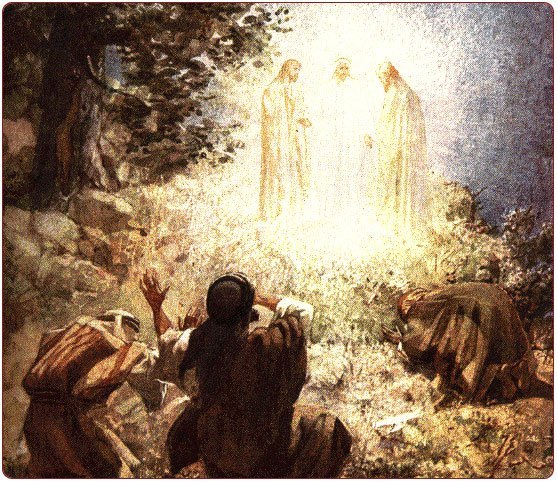 Before the three disciples would see Him in Glory again, they would have to come down from Tabor, then walk with Him towards a different Hill. And later they all would have their own dying to do, till finally they are where they are now, with Him perpetually in Glory.
Before the three disciples would see Him in Glory again, they would have to come down from Tabor, then walk with Him towards a different Hill. And later they all would have their own dying to do, till finally they are where they are now, with Him perpetually in Glory.
But not yet.
Too Much for Mortals to Handle
While Peter was still speaking a bright cloud overshadowed them, a cloud such as Moses had seen atop Mount Sinai, a cloud which on the Mount of Olives would take the risen Lord into Heaven. And a voice from the cloud: “This is my beloved Son: in Him I am well pleased. Hear Him.” (I’ve wondered if these last two words were the Father’s way of saying: Peter, hush! Listen to Jesus!)
This was suddenly more than the disciples could handle. They fell on their faces, overcome, greatly afraid. The appearance of the Holy, even of angels, usually terrifies people. That’s why at such times they need to be told, “Fear not.” “Do not be afraid.” Some time after this (how long? I don’t think they knew) they felt His hand on their shoulders and heard His familiar voice: “Arise, do not be afraid”. They looked up and saw Jesus only – no light, no one with Him. They must still have been shaking. But it was the “real” Jesus again, as they had known Him.
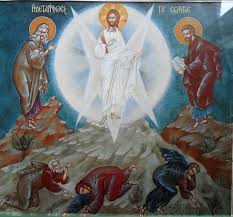
But no. For a moment they had for the first time seen the Real Jesus – Christ our God in His Glory. The Jesus they had known had been the “hidden God”. In our hymns we sing of Christ’s coming to earth “without leaving Heaven”, “without leaving his Father’s side”. All this time, from the moment of His Conception in the womb of the Virgin, Jesus Christ had been not only on earth but also in Heaven.
Don’t even try to visualize this. We can’t get this into our little minds. But all the evidence we have leads to this one inescapable conclusion: He was not only a Man, but at the same time also fully “God from God, Light from Light”. Did you ever wonder why we say those words in the Creed? It’s because of the Transfiguration. For just a moment the veil had been lifted and they had seen Him as He is – in the uncreated Light of Heaven. But only for a moment. They couldn’t handle any more. Not yet.
As He led them down the mountain He said, “Tell this vision to no one till the Son of Man has risen from the dead.” It would be like trying to describe blue to a blind man. It’s like trying to describe the Transfiguration or the Resurrection to us who have not seen it! That’s why we use symbolism, not realism, in our icons. That’s why Orthodox who have mystical experiences rarely speak of them. There’s no point.
And now for the disciples, for a while, life with Jesus went back to normal. But in another way it did not, for it says, “Now He set His face towards Jerusalem”.
Recalling the Transfiguration
In the Epistle appointed for the Transfiguration (2 Peter 10-19) we find Peter thirty years later, soon before his martyrdom which he knows is coming. As he wrote, he was remembering the Transfiguration and what it meant to him. “While I am still in 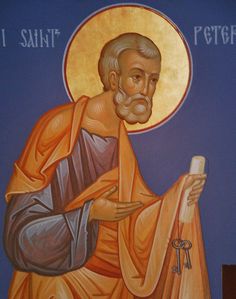 this ‘tent’” – surely thinking back to the “tents” he had wanted to build on Mount Tabor and could not. He was a young man then. Now he is older and he understands. Now he knows deep within him what he had always known superficially – that even his body is a tent, a temporary dwelling place which he won’t keep forever.
this ‘tent’” – surely thinking back to the “tents” he had wanted to build on Mount Tabor and could not. He was a young man then. Now he is older and he understands. Now he knows deep within him what he had always known superficially – that even his body is a tent, a temporary dwelling place which he won’t keep forever.
“Before I die”, he means, “I want to remind you [of how] we were eyewitnesses of His majesty. For we received from God the Father Glory and honor when the voice came to Him from the Highest Glory: ‘This is my beloved Son in whom I am well pleased’. We heard this voice which came from heaven when we were with Him on the holy mountain.”
Peter could never forget. It was the confirmation that he had been right: “You are the Son of the Living God.” He continues, “We have the prophetic word confirmed, which you do well to heed as a light that shines in a dark place till the day dawns and the morning star rises in your hearts.” The Transfiguration was to him “a light shining in a dark place” – this dark place, this dark confusing world where the darkness of death gets us all and casts its shadow over our hearts and minds long before that. …“till the Day comes”, the great Day of our Lord Jesus Christ, “and the Morning Star rises in your hearts”, Christ the Rising Sun. And we will see for ourselves Jesus Christ, the true Light.
Even more, the Day when Christ will share His glory with us. He gives us, Peter says “an entrance into heaven”, for He is not only true God but also true Man. Jesus Christ is mankind caught up into the Glory. The Transfiguration is a picture of our future, if we will have it – when, in a way we cannot yet imagine, the light of heaven will shine also from within us.
The Apostle John wrote later, decades after Peter’s death. He also was thinking back to the Transfiguration. In his first Epistle, he wrote those words which we Orthodox so often quote: “What we will be has not yet been made known. But we know that when Christ appears, we shall be like Him, for we shall see Him as he is.” 1 John 3:2.
Brothers and sisters, if we will have it, we also will be transfigured; we also will be glorified; we also will be “metamorphosized”. Jesus Christ will turn us caterpillars into butterflies.  With the Theotokos, whose glorification we will celebrate on August 15, we also are to become gods and goddesses, “more honorable than the cherubim, more glorious beyond compare than the seraphim”. As Saint Athanasios wrote, “God became Man so that man might be god.”
With the Theotokos, whose glorification we will celebrate on August 15, we also are to become gods and goddesses, “more honorable than the cherubim, more glorious beyond compare than the seraphim”. As Saint Athanasios wrote, “God became Man so that man might be god.”
Next Week and the Week after my mind will be taking August off, so another repeat, perhaps improved a bit: “Why do we honor Mary? Because the Bible says so!”
Thank you Father Bill. With love / Mats
Thanks, Mats. (As perhaps you can tell, Mats is a dear friend of ours.)
Hmmmmmmmmm…